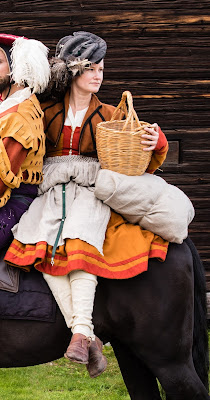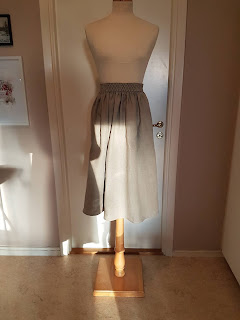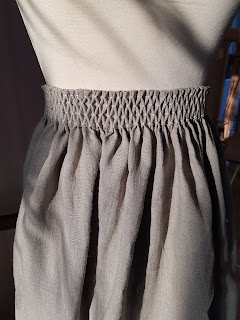Marlein, little Mary, how was your life? Was life on campaign
really better? What kind of life did you left behind? Are you leaving to
join the armylife for money and wealth, for booty? Has the fools gold
tricked you in to making these choices for yourself, or didn't you have
any other choice?
Are you married to him? Or did you in May struck a deal? Is the May marriage what you wanted? Do you love him? How is he, your man? Does he show you affection when you feed him, nurse him, care for his clothing and put up his tent? Is there any affection or only need? He certainly need you for his survival. Together you and him, to faced the challenges of war.
And what about life on campaign? Was it hard work, digging trenches,
carrying all his stuff, mounting cannons, putting up tents, cooking? What little extra could you bring to the table? Did you sew, bake, sell small luxuries to the troops? Or did you dealing with strong drinks? We saw the other woman with the cradle full of it.. Or did you and your man have a trade together? You carried and had control of the money in the purse didn't you? And he just carried his weapons, looking spiffy, and you did all the hard work? A good thing of course, when he was at the front line, that the money were safe with you. What rank
did he have? Did that help you climb in the world of the army? Did the wives
look down on you, enjoying the higher status in camp than you, just because you where there in a may marriage? Where there fighting among
you women, or did you all help each other cope? Had a good time around
the fire at night? Protecting each other in this male dominated world?

Didn't he get paid this time either? If you dreamed of pillaging, how are you handling the brutality of it now? That the people of the city despise you. The danger you face. Or is it such a necessity that you could not afford the luxury of doubt? A necessity or a chance of booty? Is it even a high? Or did you see your parents mirrored in the peasant or the towns people, in fact recognize the same circumstances in with you grew up? Any conflicted feelings in stealing? In seeing people from your camp stealing, raping, killing? Just turned a blind eye? Did you turn into the predator and they the prey? How hard is your mind? And where did the young woman dreaming of adventure go? How brave and how hard did this life force you to become?

Where you scared? Was he? Did you give each other psychological support? Did your presents help him cope with the danger of war? Probably a support, an understanding, that no one in the outside world
could provide. That only someone who has been on campaign could
understand, the stress and the horror. The fear. Did he got injured? Did you run to the front line to try to save him? Did you got injured?
Did he gave you that beautiful brocade jacket? More fancy than anything you ever wore before. Were did he steal it? Or did he actually got paid this time? No, he took it from the tailor in the last town, right? What a beautiful creature you became. How does it feel to suddenly wear something you have never been able to before, back home, when brought up under sumptuary law? Wearing something that was forbidden for your social class. Feeling over-dressed? A little bit forbidden? Or just like you belong?
What if he dies? So vulnerable you became, so you might marry again. So soon? Maybe the only way to not became every man´s woman was to chose just one new. Where you afraid of rape? Did the masculine world of military life effect yours and other woman's relationships? Did men fought around you, about you? How much say did you have in it? Or did you make men fight for you, for your precedence in camp? Did you take part in fights with the other women?
And how was marching, life on the road? In the baggage train. Anyone ever raided the train? An enemy army maybe? Or maybe your own, when the hunger got to hard and no payment was in sight. Were you afraid of getting captured? If your army would loose...
Did you sleep out in the open? Or did you have the luxury of getting to sleep in a house that you happened to walk by? Did you have the opportunity to ride on a wagon or did you walk? What happened if you got pregnant? And after childbirth, could you afford a days rest or did you have to keep walking straight away? Such a power that lays in women, so much you needed to handle.
Marlein, little Mary, how was your life?
Woodcut: Johannes Stumpf Schwytzer Chronica 1554
May marriage: A deal, a long-term relationship between a soldier and a woman, an arrangement for a campaign. But not married.
Photos taken by Anders Ragnarsson och Linda Öhman.
Inspiration: Women, Armies, And Warfare in Early Modern Europe by John A. Lynn II



















































